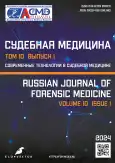Применение искусственного интеллекта и чипирования человека в судебно-медицинской экспертизе: научный обзор
- Авторы: Садыков М.Б.1, Бегалиев Е.Н.1, Бахтеев Д.В.2, Казиева А.Н.3, Хусаинов О.Б.3
-
Учреждения:
- Академия правоохранительных органов при Генеральной прокуратуре Республики Казахстан
- Уральский государственный юридический университет имени В.Ф. Яковлева
- Казахский национальный педагогический университет имени Абая
- Выпуск: Том 10, № 1 (2024)
- Страницы: 88-98
- Раздел: Научные обзоры
- URL: https://bakhtiniada.ru/2411-8729/article/view/254430
- DOI: https://doi.org/10.17816/fm16093
- ID: 254430
Цитировать
Полный текст
Аннотация
В статье изложены некоторые аспекты применения искусственного интеллекта и чипирования человека в судебно-медицинской экспертизе, в том числе с урегулированием этических и правовых вопросов, на примере публикаций учёных Республики Казахстан и зарубежных государств. Отмечено, что системы искусственного интеллекта на данном этапе развития науки и техники наибольшее применение нашли в судебной психиатрии.
В целом на фоне выявленных недостатков отмечается отсутствие работ, затрагивающих тему синергии искусственного интеллекта и чипирования человека для использования в судебно-медицинской экспертизе, а также юридических и этических аспектов их применения в этой сфере, в связи с чем авторами выполнен SWOT-анализ, показавший наличие у данных технологий ряда преимуществ и возможностей с точки зрения эффективности и точности.
На основе изучения данных литературы и практического применения искусственного интеллекта и чипирования человека в судебно-медицинской экспертизе определены правовые и этические аспекты, связанные с синергией искусственного интеллекта и чипирования людей, которые условно можно разделить на несколько ключевых, перекликающихся между собой областей: конфиденциальность и безопасность данных, информированное согласие, владение и контроль ― для правовых и уважение автономии, конфиденциальность и этика обработки данных, отсутствие вреда, информированное согласие ― для этических аспектов.
Ключевые слова
Полный текст
Открыть статью на сайте журналаОб авторах
Мухтар Бейбутович Садыков
Академия правоохранительных органов при Генеральной прокуратуре Республики Казахстан
Автор, ответственный за переписку.
Email: mukhtar.sadykov@gmail.com
ORCID iD: 0000-0002-1705-0157
SPIN-код: 2224-4845
Казахстан, Косшы
Ернар Нурланович Бегалиев
Академия правоохранительных органов при Генеральной прокуратуре Республики Казахстан
Email: ernar-begaliev@mail.ru
ORCID iD: 0000-0001-6659-8576
SPIN-код: 1929-3392
д-р юр. наук, профессор
Казахстан, КосшыДмитрий Валерьевич Бахтеев
Уральский государственный юридический университет имени В.Ф. Яковлева
Email: dmitry.bakhteev@gmail.com
ORCID iD: 0000-0002-0869-601X
SPIN-код: 8301-7165
д-р юр. наук, доцент
Россия, ЕкатеринбургАсель Негметовна Казиева
Казахский национальный педагогический университет имени Абая
Email: assel01@mail.ru
ORCID iD: 0000-0002-7734-4667
SPIN-код: 6172-0214
канд. экон. наук
Казахстан, АлматыОлег Баяхметович Хусаинов
Казахский национальный педагогический университет имени Абая
Email: oleg.khusainov.60@inbox.ru
ORCID iD: 0000-0003-4065-1652
SPIN-код: 8592-4410
канд. юр. наук
Казахстан, АлматыСписок литературы
- Fang Y.T., Lan Q., Xie T., et al. New opportunities and challenges for forensic medicine in the era of artificial intelligence technology // Fa Yi Xue Za Zhi. 2020. Vol. 36, N 1. P. 77-85. EDN: TOXTKZ doi: 10.12116/j.issn.1004-5619.2020.01.016
- Кокин А.В. Судебная экспертиза в эпоху четвертой индустриальной революции (Индустрии 4.0) // Теория и практика судебной экспертизы. 2021. Т. 16, № 2. С. 29-36. EDN: MEMZCO doi: 10.30764/1819-2785-2021-2-29-36
- Piraianu A.I., Fulga A., Musat C.L., et al. Enhancing the evidence with algorithms: How artificial intelligence is transforming forensic medicine // Diagnostics. 2023. Vol. 13, N 18. P. 2992. doi: 10.3390/diagnostics13182992
- Thurzo A., Kosnáčová H.S., Kurilová V., et al. Use of advanced artificial intelligence in forensic medicine, forensic anthropology and clinical anatomy // Healthcare (Basel). 2021. Vol. 9, N 11. P. 1545. EDN: RGJPVF doi: 10.3390/healthcare9111545
- Воеводкин Д.В., Рустемова Г.Р., Бегалиев Е.Н., и др. К вопросу выявления поддельных заключений судебно-медицинских экспертиз посредством применения технологии искусственного интеллекта по опыту Республики Казахстан: научный обзор // Судебная медицина. 2023. Т. 9, № 3. С. 287-298. EDN: EFNJIE doi: 10.17816/fm8270
- Lefèvre T. Artificial intelligence in forensic medicine. Living reference work entry. Springer International Publishing, 2021. P. 1-9.
- Tortora L., Meynen G., Bijlsma J., et al. Neuroprediction and A.I. in forensic psychiatry and criminal justice: A neurolaw perspective // Front Psychol. 2020. Vol. 11. P. 220. doi: 10.3389/fpsyg.2020.00220
- Linthicum K.P., Schafer K.M., Ribeiro J.D. Machine learning in suicide science: Applications and ethics // Behav Sci Law. 2019. Vol. 37, N 3. P. 214-222. doi: 10.1002/bsl.2392
- Pigliucci M. The end of theory in science? // EMBO Rep. 2009. Vol. 10, N 6. P. 534. doi: 10.1038/embor.2009.111
- Fernandes K, Cardoso JS, Astrup BS. A deep learning approach for the forensic evaluation of sexual assault // Pattern Anal Applic. 2018. Vol. 21. P. 629-640. doi: 10.1007/s10044-018-0694-3
- Турсунов А.Б., Галицкий Ф.А., Бегалиев Е.Н., и др. Криминалистические и судебно-экспертные аспекты детского травматизма в результате бытовых травм и дорожно-транспортных происшествий: научный обзор // Судебная медицина. 2023. Т. 9, № 3. С. 299-308. EDN: ORUBFH doi: 10.17816/fm12389
- Guez S., Laugier V., Saas C., Lefèvre T. L’IA, le légiste et le magistrat: Traitement médicolégal des violences interpersonnelles. In: Julia G., editor. Sciences et sens de l’intelligence artificielle, Thèmes et commentaires. Dalloz, 2020.
- Cantürk I., Özilmaz L. A computational approach to estimate postmortem interval using opacity development of eye for human subjects // Comput Biol Med. 2018. Vol. 98. P. 93-99. doi: 10.1016/j.compbiomed.2018.04.023
- Abugabah A., Nizamuddin N., Abuqabbeh A. A review of challenges and barriers implementing RFID technology in the Healthcare sector // Procedia Computer Science. 2020. Vol. 170. P. 1003-1010. doi: 10.1016/j.procs.2020.03.094
- Оракбаев А.Б., Курмангали Ж.К., Бегалиев Е.Н., и др. К вопросу об использовании результатов виртуальной аутопсии (виртопсии) в ходе расследования преступлений: научный обзор // Судебная медицина. 2023. Т. 9, № 2. С. 183-192. EDN: OEERGD doi: 10.17816/fm774
- Баринов Е.Х., Романова О.Л., Сундуков Д.В., и др. Случай гибели в канализационном коллекторе // Вятский медицинский вестник. 2023. № 3. С. 98-101. EDN: KMYMKX doi: 10.24412/2220-7880-2023-3-98-101
- Reardon S. AI-controlled brain implants for mood disorders tested in people // Nature. 2017. Vol. 551. P. 549-550. doi: 10.1038/nature.2017.23031
- Iqbal F., Debbabi M., Fung B.C. Artificial intelligence and digital forensics. In: Machine learning for authorship attribution and cyber forensics. International Series on Computer Entertainment and Media Technology. Springer, Cham, 2020. P. 139-150.
- Gerke S., Minssen T., Cohen G. Ethical and legal challenges of artificial intelligence-driven healthcare // Artificial Intelligence in Healthcare. Academic Press, 2020. С. 295-336. doi: 10.1016/B978-0-12-818438-7.00012-5
- Rawling P. Deontology. Cambridge University Press, 2023. doi: 10.1017/9781108581196










